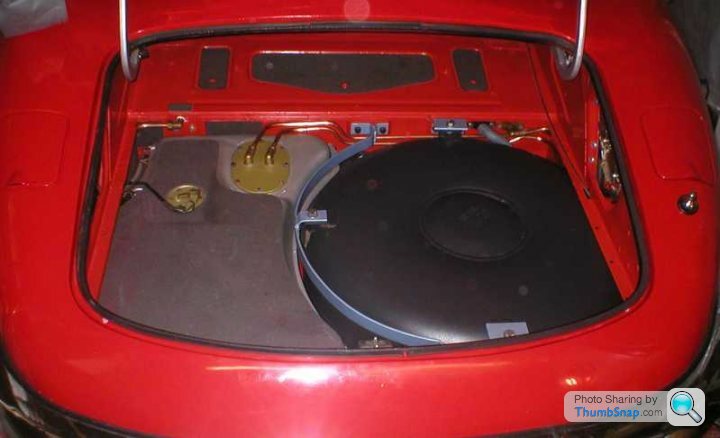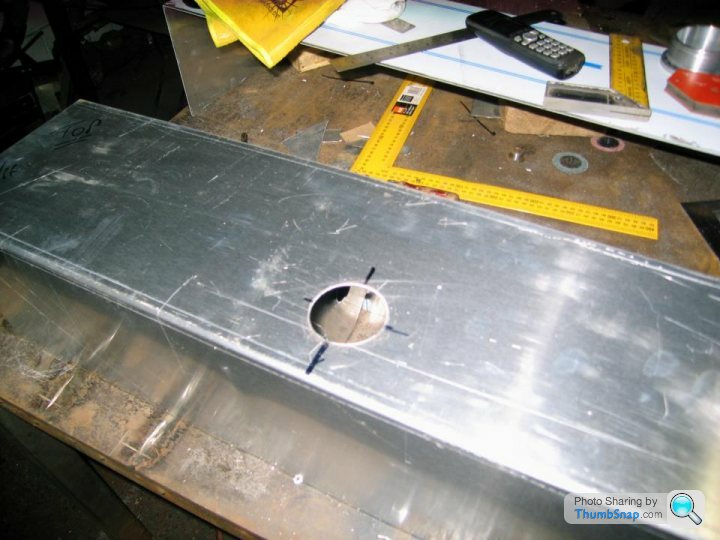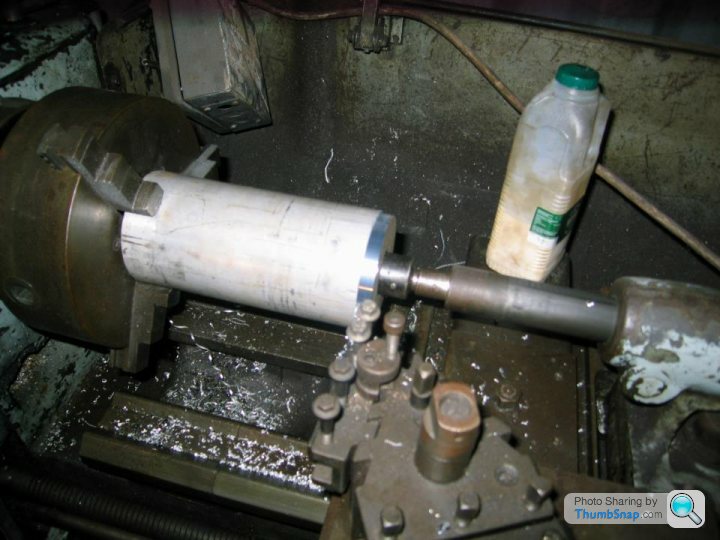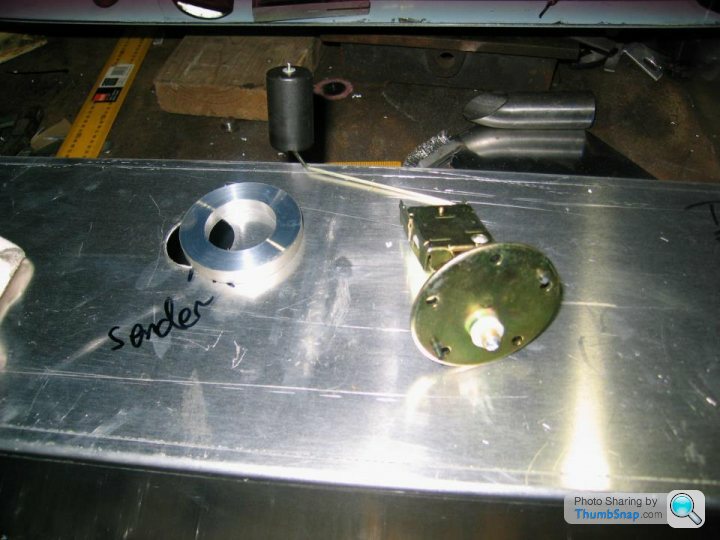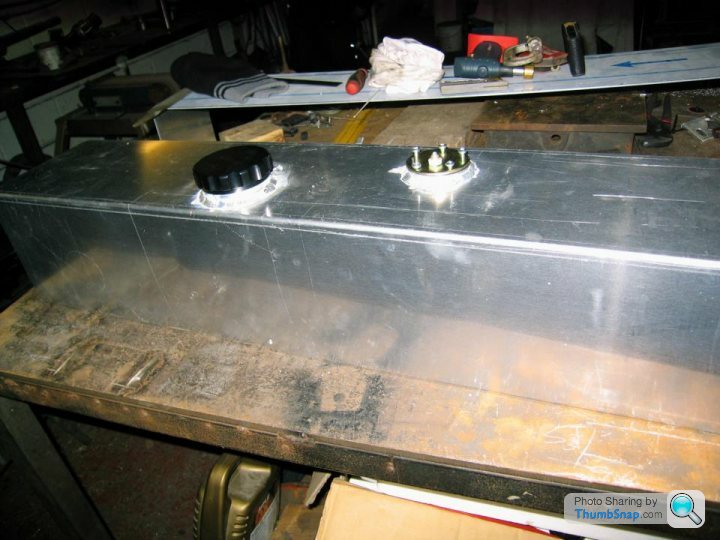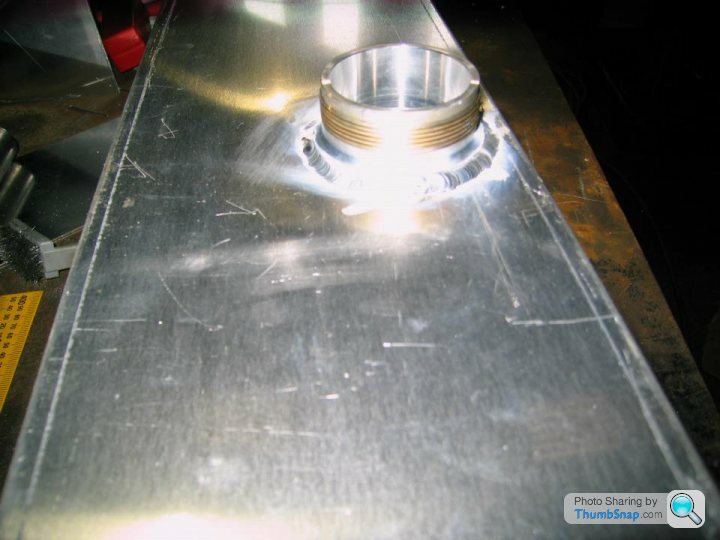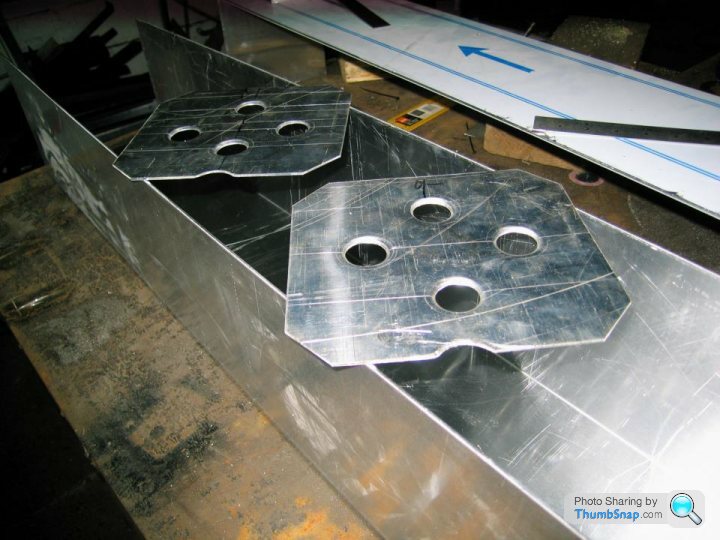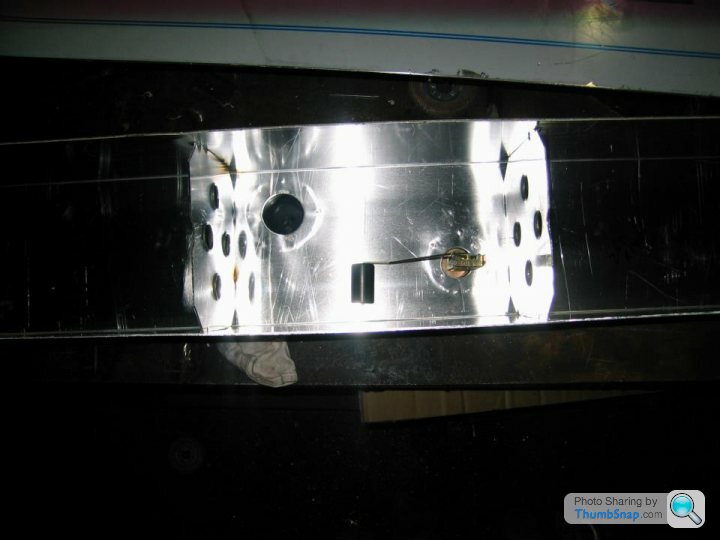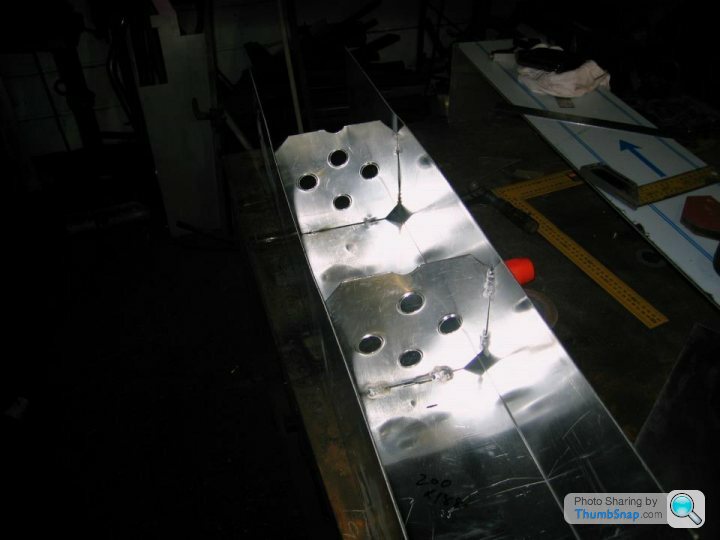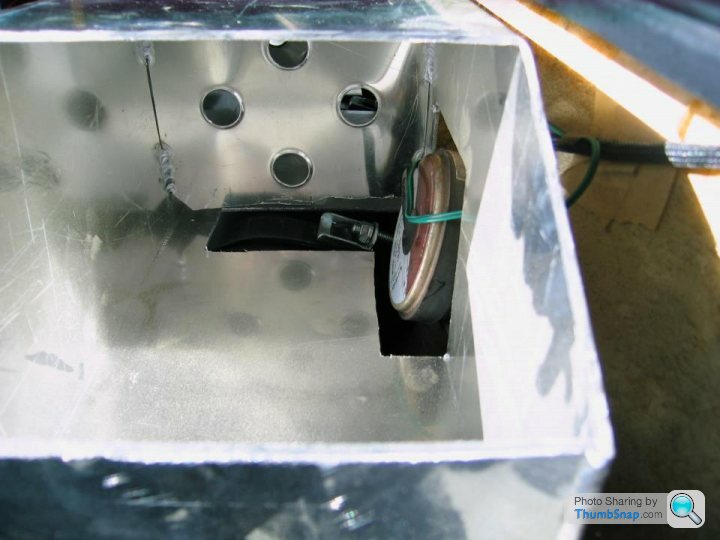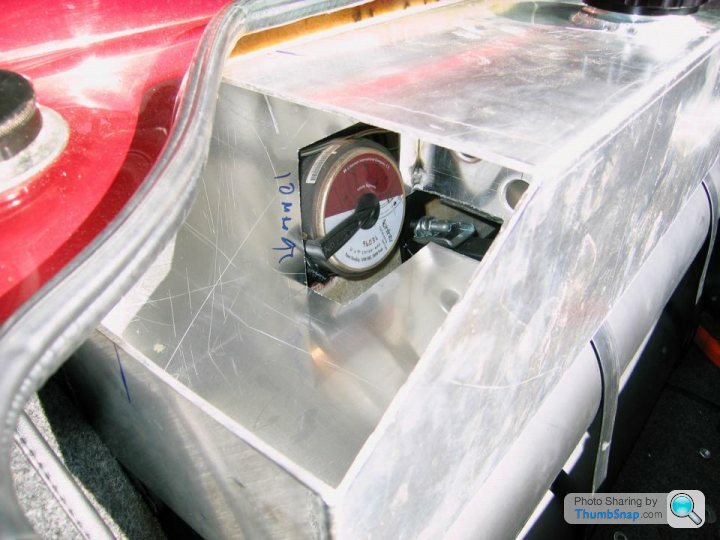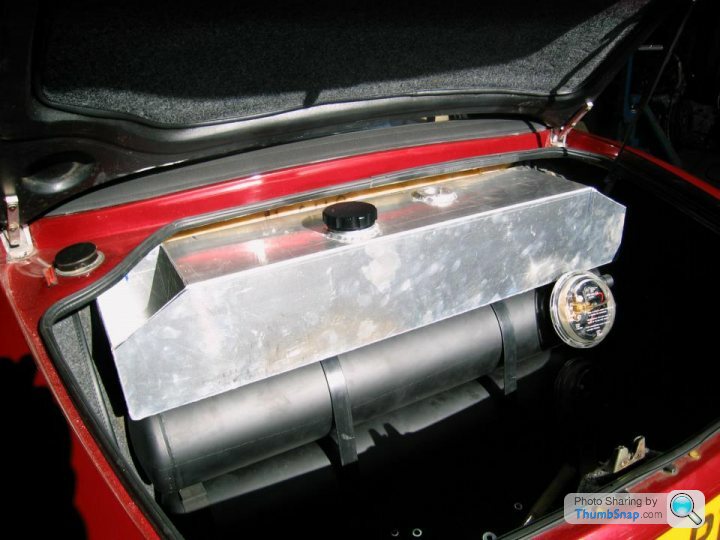LPG Chimaera (Follow My Conversion)
Discussion
Ribol said:
ChimpOnGas said:
The other thing I was thinking today when looking at the three horizontal bars, was resonance.
If that is an issue then they are too thin to do the job in the first place 
I love it when people start a sentence with...
"This is not nitpicking in any way but"
It doesn't take a genius to know what's coming next

Sorry my frame displeases you, but personally I think it will be just fine

I'm looking forward to your next interesting project mate.
Ribol said:
ChimpOnGas said:
I love it when people start a sentence with...
"This is not nitpicking in any way but"
It doesn't take a genius to know what's coming next
Please don't this the wrong way but you really are a complete jerk."This is not nitpicking in any way but"
It doesn't take a genius to know what's coming next

You posted "Intelligent constructive criticism is always welcomed", which is what I have posted.
If you don't want any, or more importantly can't take any because you are too much of a smart @rse then don't ask for it.
Any clearer for you?
Both are conspicuous by their absence in all your responses Ribol.
Other people have noted your b
 hy tendencies early on with this post, so it's most definitely not just me.
hy tendencies early on with this post, so it's most definitely not just me.The last person that challenged your attitude to me, you named a Muppet, which is just rude really.
Then you call me a Jerk?
Shame really, I expect your quite a nice genuine guy in real life, its the forum thing that screws everything up in my opinion.
Anyway, I know you are interested in the project, because you have always been all over every TVR LPG post I've ever seen, like a rash.
Which is cool with me, I even remember you saying...
"If I thought it could be done properly I would have done it myself"
So I see you as one of my followers, keep holding my hand & I'll take you through it

Moving on folks 
The Canems Dual Fuel loom for the LPG injectors, vaporiser solenoid ect, has been released from it's hiding place where the Lloyd team neatly left it.
For anyone interested in the Canems Dual Fuel system, it comes complete with all the connectors & wiring to greatly simplify your LPG installation.
I've been running this system on petrol for eight months, it's proved to be better that I ever could have hoped, like any decent stand alone engine management system it's a real game changer when compared with the Lucas 14CUX fuel & distributor ignition.
With the Canems Dual Fuel ECU you get all the benefits of something like the excellent Emerald ECU, but the option to easily go dual fuel at a later date without the need for a second LPG ECU or additional wiring.
The LPG injectors are now fully wired in, and the petrol tank fabrication is well under way.
The 7 gallon aluminium auxiliary petrol tank will be the trickiest part of the fabrication by far, making the most of the available space & mounting it safely are key.
Eliminating slosh with baffles, accommodating the rear speakers & getting the tank sender wand to move freely over its full range without fouling the complicate internal structure will be fun.
Add the inlet, outlet, breather and filler neck; & we can start to see this is by no means just an empty ally box.
Once the tank is made & fitted I feel we will have turned a significant corner, after that it's playing about making the two matching TVR fuel gauges show the correct gas & petrol levels.
All being well, the critical LPG mapping will start in earnest towards the end of the week.
Enter centre stage Mark, the mapper
Mark starts with the excellent existing petrol map developed by Lloyd Specialist Developments, which will continue to be my petrol map completely unaltered.
With input from Keith the LPG expert, Mark will build a best guess LPG map as a starting point.
From there, it's on to the rolling road where the real work begins.
Estimated completion date "This Saturday"

The Canems Dual Fuel loom for the LPG injectors, vaporiser solenoid ect, has been released from it's hiding place where the Lloyd team neatly left it.
For anyone interested in the Canems Dual Fuel system, it comes complete with all the connectors & wiring to greatly simplify your LPG installation.
I've been running this system on petrol for eight months, it's proved to be better that I ever could have hoped, like any decent stand alone engine management system it's a real game changer when compared with the Lucas 14CUX fuel & distributor ignition.
With the Canems Dual Fuel ECU you get all the benefits of something like the excellent Emerald ECU, but the option to easily go dual fuel at a later date without the need for a second LPG ECU or additional wiring.
The LPG injectors are now fully wired in, and the petrol tank fabrication is well under way.
The 7 gallon aluminium auxiliary petrol tank will be the trickiest part of the fabrication by far, making the most of the available space & mounting it safely are key.
Eliminating slosh with baffles, accommodating the rear speakers & getting the tank sender wand to move freely over its full range without fouling the complicate internal structure will be fun.
Add the inlet, outlet, breather and filler neck; & we can start to see this is by no means just an empty ally box.
Once the tank is made & fitted I feel we will have turned a significant corner, after that it's playing about making the two matching TVR fuel gauges show the correct gas & petrol levels.
All being well, the critical LPG mapping will start in earnest towards the end of the week.
Enter centre stage Mark, the mapper

Mark starts with the excellent existing petrol map developed by Lloyd Specialist Developments, which will continue to be my petrol map completely unaltered.
With input from Keith the LPG expert, Mark will build a best guess LPG map as a starting point.
From there, it's on to the rolling road where the real work begins.
Estimated completion date "This Saturday"

Dr Mike Oxgreen said:
Guys, let's chill! This is a really good thread, let's not spoil it with mud-slinging.
My hunch is that the frame could conceivably suffer resonance regardless of how strong it is, so Chimpy's right to consider the issue and mitigate against it.
Intuitively I'd think that the resonant frequency will change depending on how much gas is in the tanks, but now I'm remembering that the period of a pendulum doesn't change if you change the weight - so perhaps that applies to any vibrating system and hence I'd be wrong!
Agreed David, thanks for your sobering influence & pulling the children apart.My hunch is that the frame could conceivably suffer resonance regardless of how strong it is, so Chimpy's right to consider the issue and mitigate against it.
Intuitively I'd think that the resonant frequency will change depending on how much gas is in the tanks, but now I'm remembering that the period of a pendulum doesn't change if you change the weight - so perhaps that applies to any vibrating system and hence I'd be wrong!
These silly squabbles add nothing to the post, and can run the risk of spoiling it.
I'm sending up the white flag again, and getting on with sharing the project with the group.
Thanks again, Dave.
Great comments from Frenchie there, thanks mate.
But you should know a gallon is bigger than a litre so it generates way more power
I have tested this theory in France Land on many occasions and my car consistently goes slower over there.
However, it's highly likely the amount of fine wine & cheese I consume while travelling France Land may have some effect on performance.
I believe this is why LPG is so readily available in France Land.
Although I have just discovered you need to fill your car backwards in France Land due to the stuff being called GPL (the correct LPG backwards).
Bonjour mon ami, your post was well cushty

But you should know a gallon is bigger than a litre so it generates way more power

I have tested this theory in France Land on many occasions and my car consistently goes slower over there.
However, it's highly likely the amount of fine wine & cheese I consume while travelling France Land may have some effect on performance.
I believe this is why LPG is so readily available in France Land.
Although I have just discovered you need to fill your car backwards in France Land due to the stuff being called GPL (the correct LPG backwards).
Bonjour mon ami, your post was well cushty


Ok Gas Sniffers lets get back to LPG.
What you guys may not know is when I started looking at all this last year I decided to place a post on the "LPG Discussion Forum".
The more technical amongst you who are interested in LPG (as I am), may want to have a read of the responses?
http://www.lpgforum.co.uk/viewtopic.php?f=30&t...
As with any forum environment there are individuals contributing with a wide range of skills & knowledge.
I encourage you to read the responses from the two respected professional LPG installers "Woody" & "Rossko".
Following my eventual decision to select the Canems Dual Fuel system, discussions began to centre around LPG fuel density corrections.
This was driven by the absence of a fuel temp input on the Canems system, all piggyback LPG systems utilise this signal which is taken at the reducer.
The main challenger being Rossko, who actually now seems to agree the LPG fuel density variables can be mapped out using the Canems software.
As Rossko says:
"I'm sure it'll be 'acceptable' as the physics work with you - under load (getting colder) you should overfuel"
My chosen installer Keith Woods "Woody" has always insisted, with the Canems system a fuel temp reference at the reducer is not required.
So lets understand exactly what's going on here.
Following the warm-up phase, during normal operating temperatures & engine load the fuel density will remain very constant as it follows engine coolant temperature.
Which in turn is governed by the thermostat, & assisted by the rad fans.
Other influencing factors are coolant capacity, coolant specific gravity, radiator surface area, air flow ect ect, which is why it's essential my cooling system is healthy & functioning correctly before I convert to LPG.
The only other factors affecting fuel density are:
As you can imagine with LPG that's returning to it's natural gaseous state from a compressed liquid, the higher the fuel demand the lower it's temperature will be, which in turn creates a higher fuel density & consequently a potential change in the AFR.
You could argue therefore the Canems DF should have a fuel delivery temperature input (which as we know it doesn't) to drive fuel density compensation.
On the face of it, it seems David at Canems may have missed a trick here, but did he?
Because the Canems DF is running a stand alone map not an emulation of the petrol map as with a piggyback, its very simple to shorten or lengthen the LPG injector duration fractionally to maintain your target AFR under load.
You would struggle to do this with a piggy back because the perimeters within the petrol map its emulating (& twisting for LPG) were never really designed to deal with such variances.
This why all piggybacks always take a fuel temp correction input from the reducer, it allows the piggyback to pull the petrol map about even further to compensate for changes in LPG fuel density.
But with the ability to directly map the Canems DF system, all the control you ever dreamt of is now directly back in the hands of the mapper
As such, when compared with a piggyback, it should still work perfectly with or without directly knowing the precise LPG fuel density at the reducer.
This is another reason for our use of EGT, close monitoring of Exhaust Gas Temperatures (in conjunction with AFR) ensures any dangerous lean conditions can be easily identified, and ultimately eliminated as part of the mapping process.
Finally, switch-over (petrol to LPG) is not automatic on the Canems, as it is with many LPG conversions.
The decision to select LPG during the petrol warm-up phase is made by me, not the ECU looking at fuel & or coolant temperatures, & actually I far prefer it like this, so yet another reason why I don't need a fuel temp sensor.
In my opinion the fuel density question remains an interesting one.
Like I've been saying all along, the devil is most definitely in the detail.
And the detail in this case is definitely the LPG mapping.
Boy, I do hope all this works out OK
What you guys may not know is when I started looking at all this last year I decided to place a post on the "LPG Discussion Forum".
The more technical amongst you who are interested in LPG (as I am), may want to have a read of the responses?
http://www.lpgforum.co.uk/viewtopic.php?f=30&t...
As with any forum environment there are individuals contributing with a wide range of skills & knowledge.
I encourage you to read the responses from the two respected professional LPG installers "Woody" & "Rossko".
Following my eventual decision to select the Canems Dual Fuel system, discussions began to centre around LPG fuel density corrections.
This was driven by the absence of a fuel temp input on the Canems system, all piggyback LPG systems utilise this signal which is taken at the reducer.
The main challenger being Rossko, who actually now seems to agree the LPG fuel density variables can be mapped out using the Canems software.
As Rossko says:
"I'm sure it'll be 'acceptable' as the physics work with you - under load (getting colder) you should overfuel"
My chosen installer Keith Woods "Woody" has always insisted, with the Canems system a fuel temp reference at the reducer is not required.
So lets understand exactly what's going on here.
Following the warm-up phase, during normal operating temperatures & engine load the fuel density will remain very constant as it follows engine coolant temperature.
Which in turn is governed by the thermostat, & assisted by the rad fans.
Other influencing factors are coolant capacity, coolant specific gravity, radiator surface area, air flow ect ect, which is why it's essential my cooling system is healthy & functioning correctly before I convert to LPG.
The only other factors affecting fuel density are:
- Fuel pressure (governed by the reducer)
- Engine load (fuel demand)
- Ambient engine bay temperature (while high in a TVR in practice this remains relatively consistent after warm-up)
As you can imagine with LPG that's returning to it's natural gaseous state from a compressed liquid, the higher the fuel demand the lower it's temperature will be, which in turn creates a higher fuel density & consequently a potential change in the AFR.
You could argue therefore the Canems DF should have a fuel delivery temperature input (which as we know it doesn't) to drive fuel density compensation.
On the face of it, it seems David at Canems may have missed a trick here, but did he?
Because the Canems DF is running a stand alone map not an emulation of the petrol map as with a piggyback, its very simple to shorten or lengthen the LPG injector duration fractionally to maintain your target AFR under load.
You would struggle to do this with a piggy back because the perimeters within the petrol map its emulating (& twisting for LPG) were never really designed to deal with such variances.
This why all piggybacks always take a fuel temp correction input from the reducer, it allows the piggyback to pull the petrol map about even further to compensate for changes in LPG fuel density.
But with the ability to directly map the Canems DF system, all the control you ever dreamt of is now directly back in the hands of the mapper

As such, when compared with a piggyback, it should still work perfectly with or without directly knowing the precise LPG fuel density at the reducer.
This is another reason for our use of EGT, close monitoring of Exhaust Gas Temperatures (in conjunction with AFR) ensures any dangerous lean conditions can be easily identified, and ultimately eliminated as part of the mapping process.
Finally, switch-over (petrol to LPG) is not automatic on the Canems, as it is with many LPG conversions.
The decision to select LPG during the petrol warm-up phase is made by me, not the ECU looking at fuel & or coolant temperatures, & actually I far prefer it like this, so yet another reason why I don't need a fuel temp sensor.
In my opinion the fuel density question remains an interesting one.
Like I've been saying all along, the devil is most definitely in the detail.
And the detail in this case is definitely the LPG mapping.
Boy, I do hope all this works out OK

Sardonicus said:
Dave you got to much time on your hands fella  ......
......  ... keep the topic going though
... keep the topic going though 
The joys of a deeply dull desk bound job Simon  ......
......  ... keep the topic going though
... keep the topic going though 

I stopped crawling under cars every day years ago, cos its cold & filthy.
Now I'm desk bound, I'm warm & clean, but bored to death.
Sad indeed

Know anything about LPG fuel density mate?
jr6yam said:
26MJ/L
Yup got that John.
Actually LPG has a typical specific calorific value of 46.1 MJ/kg compared with 43.5 MJ/kg for premium grade petrol.
Sounds encouraging right?
Well not exactly, LPG has an energy density per volume unit of 26 MJ/l (your figure), which is 20% lower than that of petrol.
Specific calorific value is very different to energy density.
However, the extremely high 110Ron octane level of LPG allows you (with a decent ignition system) to recover the potential performance loss, LPG also has a simpler carbon molecular chain.
Which means LPG is easier to burn & extract power from than petrol.
It's all down to those cheeky free radicals, don't you know

So with a mappable ignition system the end result is zero loss of power.
"The Lord Giveth & The Lord Taketh Away" leaving you with neither a gain or a loss.
But the reduction in calorific value will impact on fuel economy, your engine needs to eat more LPG Mars Bars than petrol Mars Bars to cover the same ground

I am working to a 15% loss in fuel economy when burning LPG over petrol, which is completely negated (& more so) given the 45% price deferential between the two fuels.
But I'm not referring to all this when I'm talking about LPG fuel density.
I'm looking at the effects of temperature on LPG fuel density.
Open the throttle especially under load, & a lot more gas is delivered, this reduces temperature which in turn changes fuel density, and ultimately will alter the air fuel ration unless compensation strategies are used.
Fortunately physics is on my side, all that will happen is the mixture will become colder & richer, which is exactly what you want.
However it could go too far, especially if coping strategies are not incorporated to mitigate the condition.
It's not really an issue TBH as it can easily be mapped out with the Canems system, but it should not be overlooked.
Told you I was bored

jr6yam said:
At what point does the LPG become gaseous?
Hi John, it doesn't take much to turn LPG to a liquid, just 160psi in fact.It compresses well too, taking up 274 times less space than it does as a gas.
When you release the pressurised liquid LPG to atmosphere it will boil, releasing vapour just like boiling water.
Except with LPG the boil happens at -42c

It's funny to think of something boiling at -42c, but that's exactly what's happening, it's the vapour released from the boil that the engine is consuming.
If you release loads of the stuff quickly, say when you accelerate hard up a hill, you get a bigger drop in temperature than you may want.
In these circumstances the density changes, therefore so does the mixture.
But we can map this out so it's no real issue, actually its an advantage, you get a nice cold richer mixture just when you need it most.
Another reason why LPG works so well with a turbo

jr6yam said:
ChimpOnGas said:
jr6yam said:
At what point does the LPG become gaseous?
Hi John, it doesn't take much to turn LPG to a liquid, just 160psi in fact.It compresses well too, taking up 274 times less space than it does as a gas.
When you release the pressurised liquid LPG to atmosphere it will boil, releasing vapour just like boiling water.
Except with LPG the boil happens at -42c

It's funny to think of something boiling at -42c, but that's exactly what's happening, it's the vapour released from the boil that the engine is consuming.
If you release loads of the stuff quickly, say when you accelerate hard up a hill, you get a bigger drop in temperature than you may want.
In these circumstances the density changes, therefore so does the mixture.
But we can map this out so it's no real issue, actually its an advantage, you get a nice cold richer mixture just when you need it most.
Another reason why LPG works so well with a turbo

As I understand it the gas is supplied to the injectors at a fairly constant pressure? Gas will reach 90% of ambient Temperature very quickly, so the
distance from the vapouriser to the combustion chamber is important; along with flow and the thermal conductivity of the pipework.
In a hot engine bay there may not be as much Temperature drop as you may think
Thanks for bringing the discussion back on LPG, it's an interesting fuel & I'm learning all the time.
Its good to know it reaches 90% of ambient temperature very quickly, makes sense from what I've seen.
We've positioned the vaporiser as close to the inlet manifold as possible and lagged the pipes, but there are always compromises in packaging on something like this.
I wanted the vaporiser hidden in the O/S inner wing near the carbon canister, great for "stealth" but not so handy when you need to get to the vaporiser to make adjustments and the run to the manifold is longer too.
I also wanted 70litres of gas not 60, but you try and find 35 litre tanks that are 1050mm long, they just don't exist & would need to be made.
If we were going to that expense I would have them made as a single Siamese tank 4 hole design, which would be absolutely perfect.
Like I say, there will always be a compromises, but I'm confident we've chosen the best compromises we can.
All being well there will be some more updates with photos this evening

Sadly we have missed our completion date of tomorrow due to parts supply delays & other minor distractions

Never underestimate the amount of time all this bespoke fabrication takes.
We are developing something for the first time here, so there is always going to be a lot of tweaks & adjustments along the way.
The next person who wants a similar conversion will benefit from our development work, they will get a fast turn-key installation that's proven, and at a fixed cost.
All they then need to do is enjoy the 45mpg or better.

Edited by ChimpOnGas on Friday 8th March 09:28
jr6yam said:
Cool
I think what you're doing is brilliant, let's face it most of us haven't got the balls to try new stuff
Just look at the furore over the Iridium plugs
Exactly John & thanks for your support.I think what you're doing is brilliant, let's face it most of us haven't got the balls to try new stuff
Just look at the furore over the Iridium plugs

But I don't feel particularly brave, because actually if your break it down, nothing I'm doing here is especially innovative.
TBH if I thought it didn't have a good chance of success I doubt I'd have the balls to attempt it myself.
The truth is all the different elements I've selected are extremely well proven in isolation, and are being applied to a very suitable platform.
We know the Canems Dual Fuel system works well, & we know the Rover V8 takes to LPG very well too.
There are literally thousands of Range Rovers doing big miles on LPG with very little evidence of problems.
It's well accepted in the LPG conversion industry the Keihin injectors are the best you can buy, & the Prins vaporiser is first rate too.
So the foundation & recipe is sound.
If you think about it a TVR Chimaera is an extremely good platform for just such a conversion, the unusually large boot, the use of the proven LPG friendly Rover V8 engine, & the flexibility & simplicity of the separate body on a separate chassis all help.
The only real trick I'm trying to pull off here is to bring all these proven elements together and package them in such a way that ensures the performance, character & practicality of the car are retained.
^^And so here lies the big challenge^^
If we can get that packaging right, the fact that each component & control system is already proven leads me to feel I am not so brave.
In fact I'd say I was being quite conservative, in my opinion the turbo will be a far bigger leap of faith than the LPG conversion.
The bottom line is there has been a lot of planning, research and playing Devils Advocate before I was 100% happy to give the project the green light, this gives me a lot of confidence & is what I continue to hold onto when the naysayers chime in.
Of course if it doesn't perform like I want (which I doubt) it will be an expensive folly, but it wont ruin the car, we'll just remove it and move on having learnt some valuable lessons.
Being cautious is not bad thing, we have taken a lot of care to ensure everything on this LPG conversion is completely removable, returning the car to petrol only with the original petrol tank & leaving no evidence whatsoever in just one day or less.
I do hope we don't need to explore this feature, but it's nice to know it's there if needed.
I'm pleased with the progress so far, and throughout the conversion nothing has suggested it will do anything other than deliver exactly what all the theory says it should.
And that's to take this charming British modern classic sports car, and remove its one big weakness.
Fuel costs!
Wish me luck

UPDATE 
Tank frame painted satin black, the upper fixings in place & sponge rubber anti chaffing pads fitted.
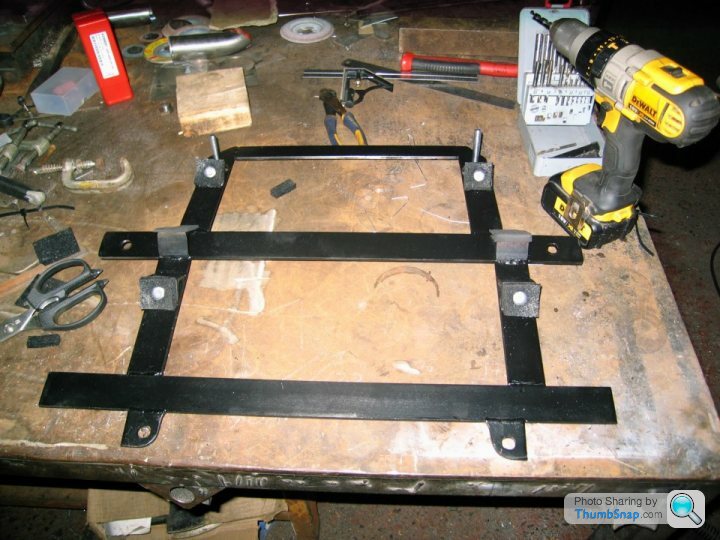
How about this for a weld? We decided going through the rear bulkhead wasn't needed, the interior stays true to the "Stealth" approach.
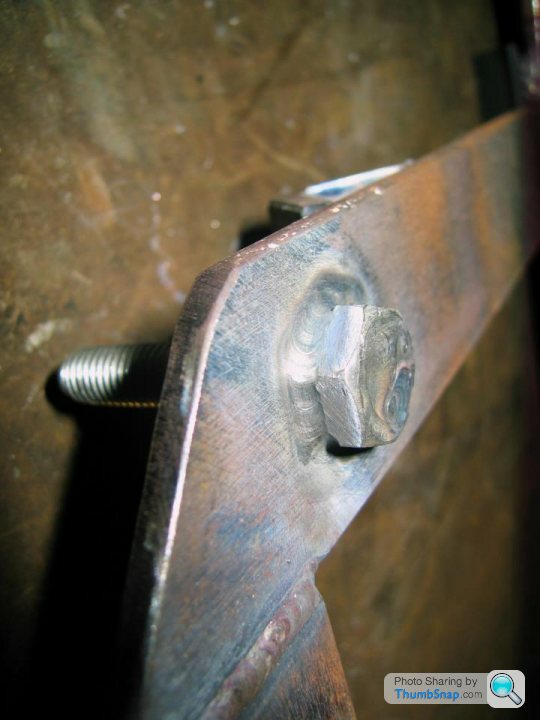
How the empty frame looks fitted to the car, you can see the neoprene bottom tank pad on the boot floor.
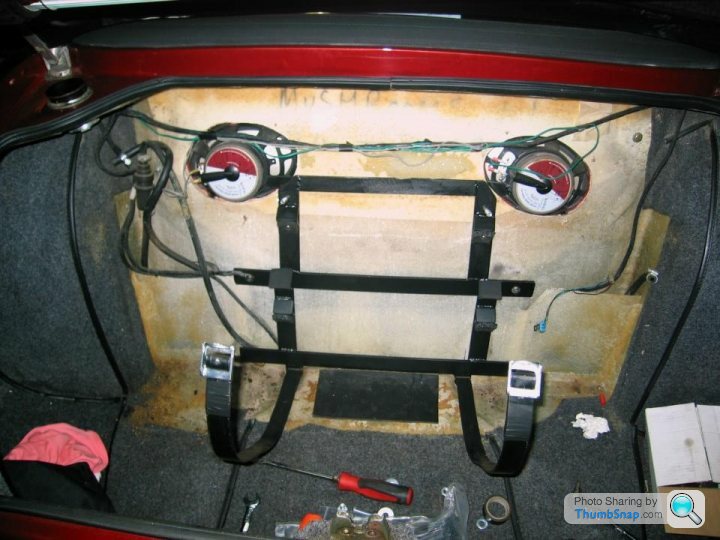
Bottom tank in place with more foam insulation at either end.
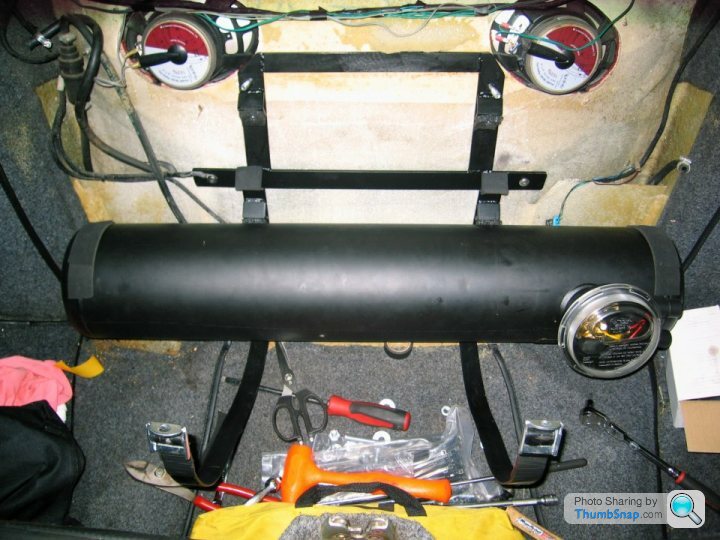
The tanks are such a great fit you'd almost think they were made for the Chimaera. Apart from a small intrusion from the valve boxes, there's no real difference in boot space to the original petrol only set up.
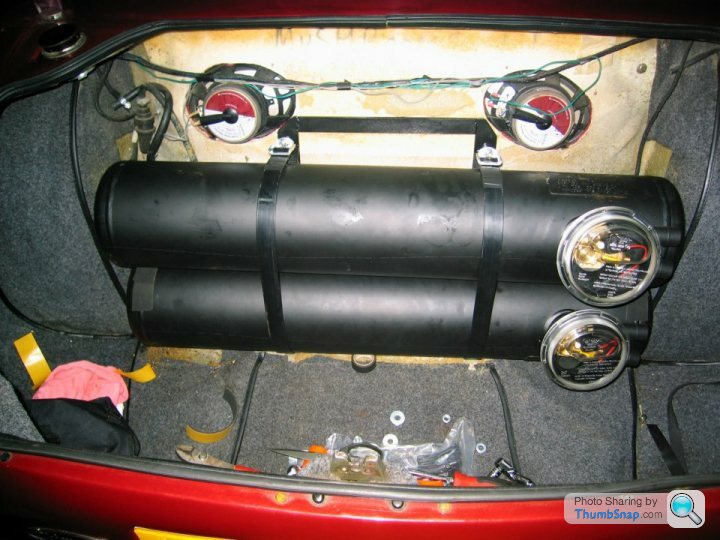
And here's the proof, the one piece roof fits just like it always did confirming a twin tank set up is the way to convert a Chimaera.
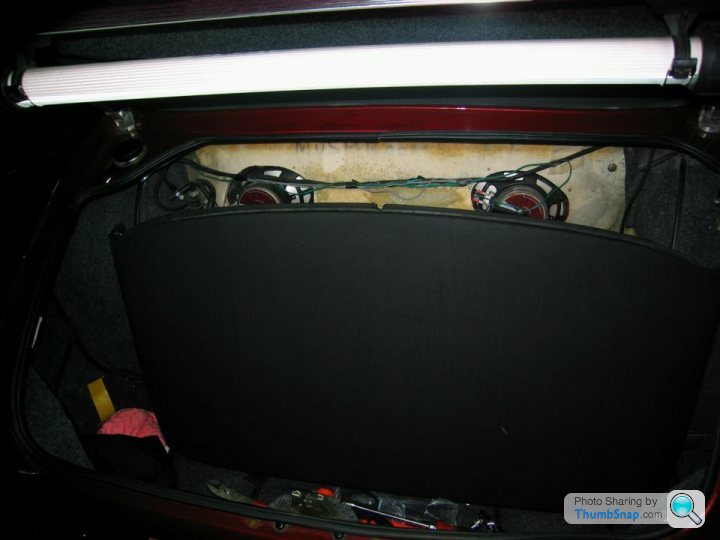
Just look at all that luggage space still available even with the roof in the boot, plenty for my next Euro tour & the dash to Le Mans. An LPG converted TVR still gives you more luggage space than any other sports car you can buy.
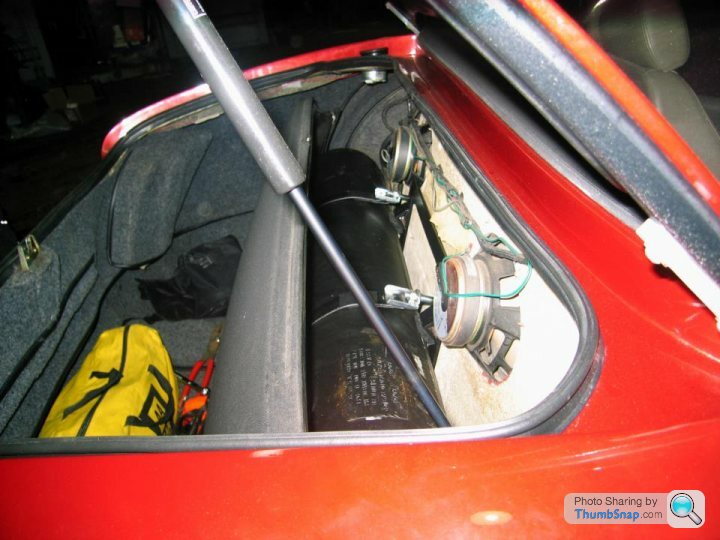
The 7 gallon petrol tank takes shape, 3mm alloy plate folded to size & the filler neck welded in place at the lowest point in relation to the boot lip.
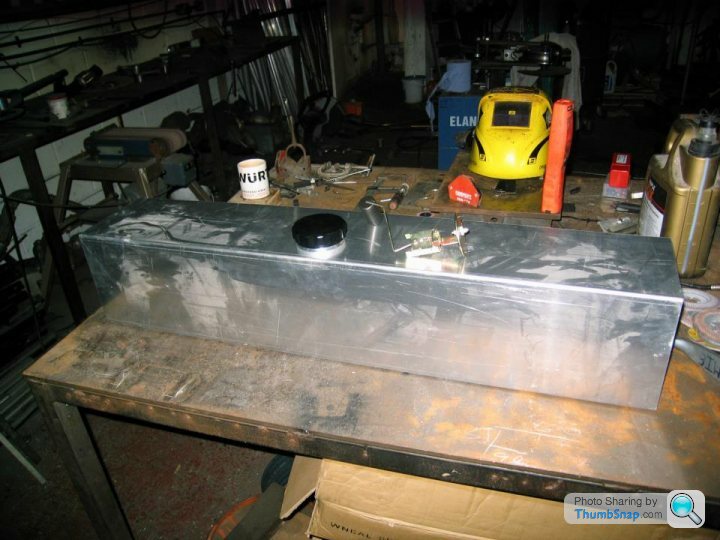
All it needs is internal baffle plates, scalloping to accommodate the rear speakers , the level sender installing, the outlet installing, the breather pipe and the return pipe...oh and fully seam welded. Give us another 10 minutes & it'll all be done.
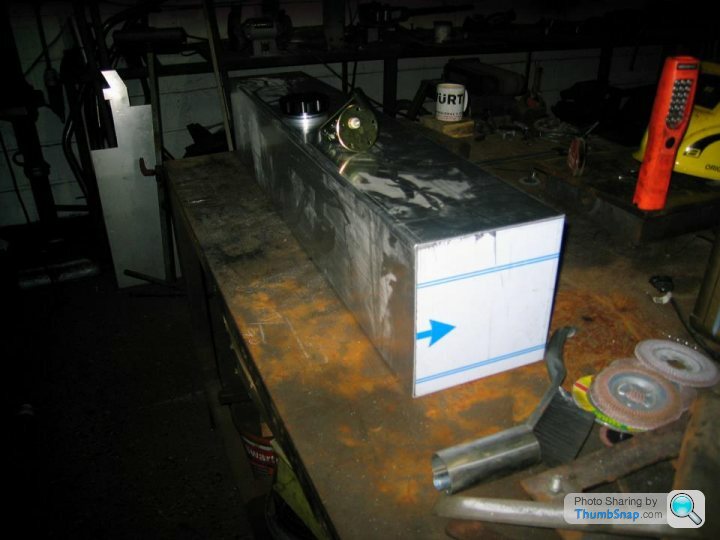
[url]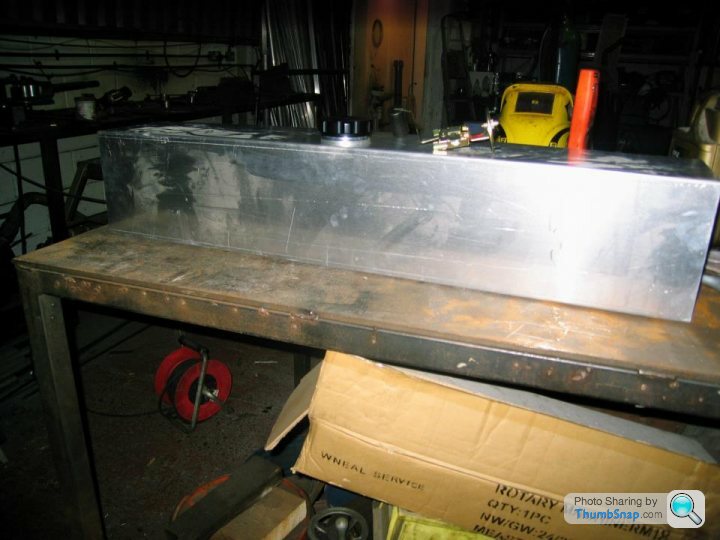 |http://thumbsnap.com/cBo1PqRL[/url
|http://thumbsnap.com/cBo1PqRL[/url
Monday should see the tank finished & the senders matching the two TVR fuels gauges.
Tuesday some pipe work & testing, followed by bringing her back to life for the fist time in 2.5 weeks.
Then its on to the rollers for the mapping, all being well next Saturday she'll be out & about for lots of real world testing.
Any minor tweaks & adjustments can be made before early April when the car will go on a mini continental run to Brugge & Brussels.
Well that's the plan as they say

Tank frame painted satin black, the upper fixings in place & sponge rubber anti chaffing pads fitted.

How about this for a weld? We decided going through the rear bulkhead wasn't needed, the interior stays true to the "Stealth" approach.

How the empty frame looks fitted to the car, you can see the neoprene bottom tank pad on the boot floor.

Bottom tank in place with more foam insulation at either end.

The tanks are such a great fit you'd almost think they were made for the Chimaera. Apart from a small intrusion from the valve boxes, there's no real difference in boot space to the original petrol only set up.

And here's the proof, the one piece roof fits just like it always did confirming a twin tank set up is the way to convert a Chimaera.

Just look at all that luggage space still available even with the roof in the boot, plenty for my next Euro tour & the dash to Le Mans. An LPG converted TVR still gives you more luggage space than any other sports car you can buy.

The 7 gallon petrol tank takes shape, 3mm alloy plate folded to size & the filler neck welded in place at the lowest point in relation to the boot lip.

All it needs is internal baffle plates, scalloping to accommodate the rear speakers , the level sender installing, the outlet installing, the breather pipe and the return pipe...oh and fully seam welded. Give us another 10 minutes & it'll all be done.

[url]
 |http://thumbsnap.com/cBo1PqRL[/url
|http://thumbsnap.com/cBo1PqRL[/urlMonday should see the tank finished & the senders matching the two TVR fuels gauges.
Tuesday some pipe work & testing, followed by bringing her back to life for the fist time in 2.5 weeks.
Then its on to the rollers for the mapping, all being well next Saturday she'll be out & about for lots of real world testing.
Any minor tweaks & adjustments can be made before early April when the car will go on a mini continental run to Brugge & Brussels.
Well that's the plan as they say

LPG Range = 300 miles
Petrol Range = 200 miles
= A 500 mile Chim
And the one piece roof panel still fits in the boot just like on the original petrol only set up.
I have done over 500 miles in one day a number of times, but I definitely felt a stop to stretch my legs was needed halfway through, so the 500 mile range is a bit pointless really.
Truth is I doubt I'll ever max the 8 gallon petrol tank capacity, I anticipate a half fill will be more than sufficient in most circumstances as it still gives an emergency 100 mile range on the expensive stuff.
I need to be sensible with the additional weight which currently looks like 40kg more than a standard brimmed petrol tank.
Carrying 5 gallons reduces this additional weight to 33kg when the LPG tanks are maxed too, any more than this and I'll really need to look at the weight of my touring luggage that day.
Carrying one bag on the parcel shelf rather than in the boot will help balance & distribute the weight a bit, but that's just for the big Euro tours.
So in summary I think I've ended up with a bit too much petrol capacity really
But hey the space is there for it, & I can always choose not use all the capacity.
Petrol Range = 200 miles
= A 500 mile Chim

And the one piece roof panel still fits in the boot just like on the original petrol only set up.
I have done over 500 miles in one day a number of times, but I definitely felt a stop to stretch my legs was needed halfway through, so the 500 mile range is a bit pointless really.
Truth is I doubt I'll ever max the 8 gallon petrol tank capacity, I anticipate a half fill will be more than sufficient in most circumstances as it still gives an emergency 100 mile range on the expensive stuff.
I need to be sensible with the additional weight which currently looks like 40kg more than a standard brimmed petrol tank.
Carrying 5 gallons reduces this additional weight to 33kg when the LPG tanks are maxed too, any more than this and I'll really need to look at the weight of my touring luggage that day.
Carrying one bag on the parcel shelf rather than in the boot will help balance & distribute the weight a bit, but that's just for the big Euro tours.
So in summary I think I've ended up with a bit too much petrol capacity really

But hey the space is there for it, & I can always choose not use all the capacity.
Gassing Station | Chimaera | Top of Page | What's New | My Stuff







